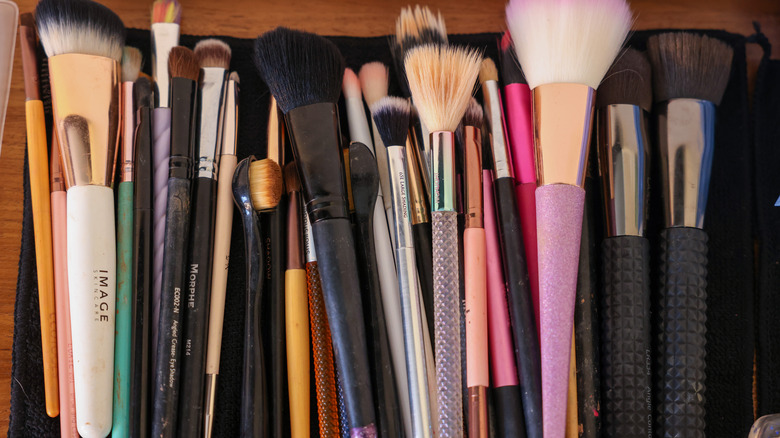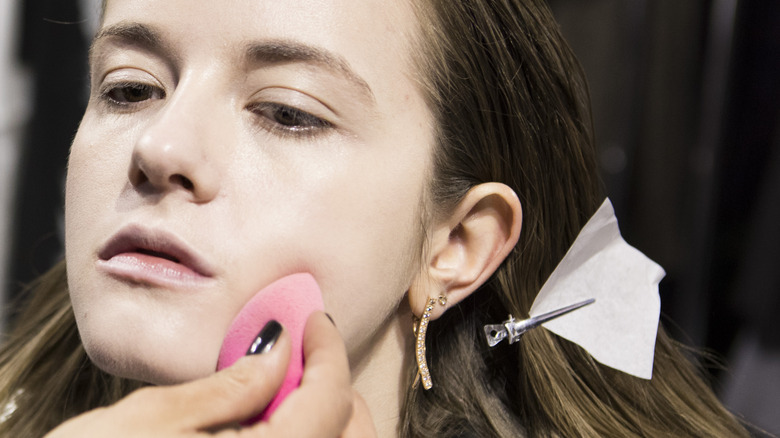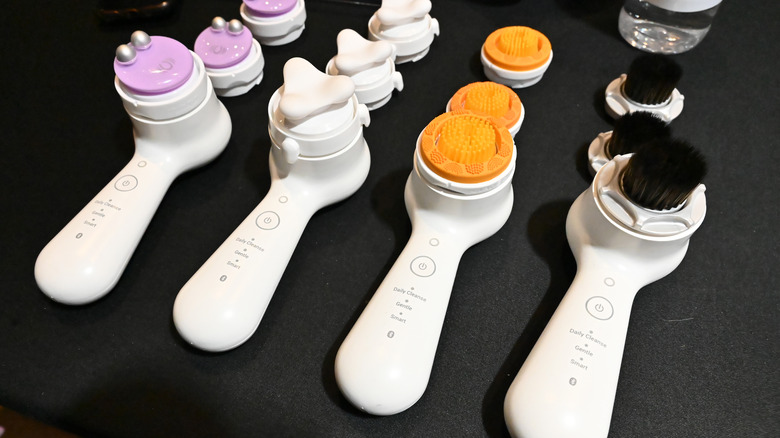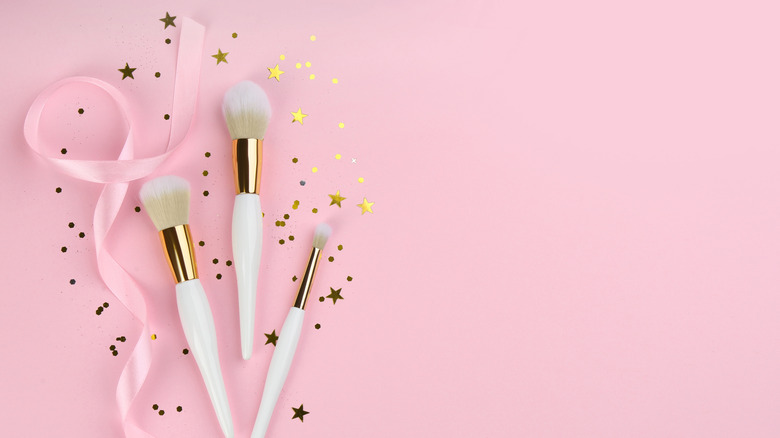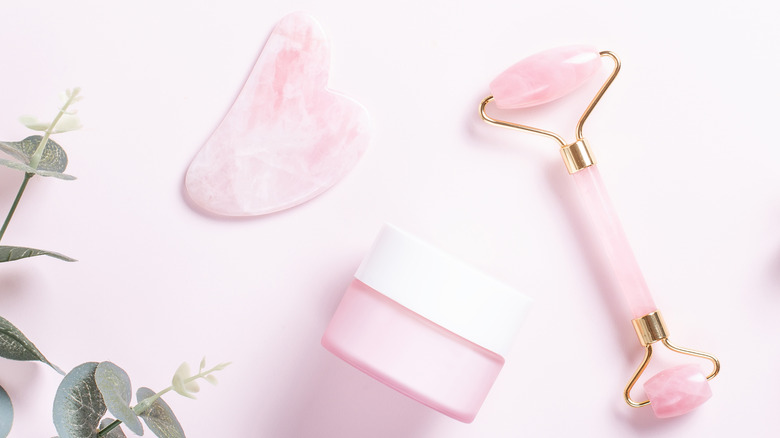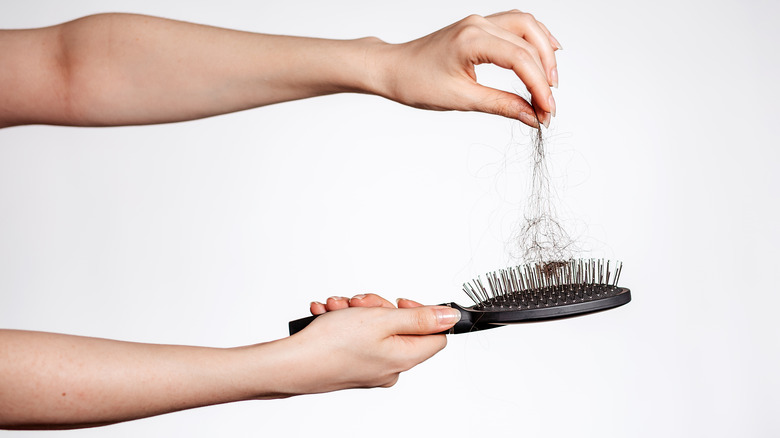How To Clean Your Most-Used Beauty Tools To Keep Them Germ Free
As gross as the thought of applying makeup with a dirty brush can be, actually cleaning your makeup brushes is one of the most disliked chores on any list. However, whether you like it or not, removing all dirt, hair, and grime from your beauty tools is key to keeping yourself healthy and glowing.
The American Academy of Dermatologists Association recommends brushing your makeup tools at least every 7 to 10 days. However, not just your makeup tools should be getting a deep cleanse. Hair tools should also be cleaned regularly to prevent germs and bacteria from getting a foothold. According to a study by the University of Arizona, uncleaned hairbrushes have more bacteria than a dog bowl (via Glamour Magazine).
With so many ways your beauty tools can get bacteria, it's a good idea to plan your future cleansing days. Even though it is a chore, cleaning your beauty tools is the best way to keep bacteria away from your skin, face, and hair and ensure your tools are working to the best of their ability.
Cleaning your makeup sponge
When using your makeup sponges many times a week, they get clogged with leftover foundation. Instead of harboring bacteria in your makeup sponge, try washing it at least every three to four uses.
Makeup.com says the best way to clean your makeup sponge doesn't take more than a few minutes. Start by soaking your sponge thoroughly with water. Afterward, lather your sponge with a few drops of gentle shampoo or soap with your hands. Lather the entire sponge until the product starts to come off. Rinse and squeeze out excess water. Run it under water until the squeezed water is clear. If you want to use your sponge damp, you may do so, or pat dry it with a towel and leave it out to dry.
To ensure your foundation is being correctly distributed across your face, take the time to clean out your sponge frequently. Once the sponge starts to deteriorate, you will need to replace it. You can also cut the sponge in half to make sure the inside of the sponge has not grown mold.
Cleaning your facial cleansing device
Since your facial cleansing device is in close contact with removing dead skin cells and your cleansers, it's a good idea to regularly clean your device to ensure it is always in tip-top shape. Because these facial cleansers are always in a wet area, you want to make sure to constantly clean to prevent the buildup of dead skin cells, excess products, and bacteria that grows in humid conditions.
Foreo suggests using mild soap and water to clean your facial cleansing device. After washing it, pat dry it with a lint-free towel to remove excess water and let it air dry. If you are cleaning an electronic facial cleansing device, Clarisonic reminds you to remove the brush head from the handle before cleaning the brush (via Allure). With an electronic brush, you can scrub on the bristles harder if you have excess dirt on them. These types of brushes are made to withstand high pressure and can take a more intense cleanse. Even with electronic devices, you can clean it like a regular facial cleansing device with warm water and mild soap.
Cleaning your makeup brushes
Your makeup brushes are one of the top places where bacteria from leftover makeup and dead skin cells accumulate. Your foundation, blush, or eyeshadow brushes will undoubtedly hold many bacteria if these tools are not adequately cleaned.
According to the New York Times, the best way to clean your makeup brushes doesn't take much. Start by wetting the brush's bristles and dropping a few drops of mild soap or brush cleaner onto the palm of your hand or a brush cleaning mat. Rub the brush onto the soap in circular motions until the product loosens. Rinse the brushes until the water runs clear. Be sure not to allow much water to trickle upwards, as this can reduce the glue holding the bristles together. Squeeze excess water out before leaving them to dry to speed up the process. Make sure also to lay your brushes flat or hang with the bristles pointing down to make sure they dry properly.
Cleaning your gua sha and jade rollers
Although beauty tools like gua shas and jade rollers seem like they don't require much maintenance, you should regularly give them a cleanse. Like brushes, these beauty tools can accumulate leftover product and oils over time.
Knesko Skin recommends wiping down your jade roller after each use to remove the excess products used. Once a week, you can deep clean your jade roller to ensure it is ready for another week of use. To deep clean, simply soak your jade roller into a bowl of warm water and mild soap for a few minutes. Afterward, pat dry your roller and lay it flat to remain dry. White Lotus agrees that the same process can also be used to clean your gua sha tools. It's also important to note that beauty tools of lesser quality will discolor over time with cleaning.
However, you want to keep these tools clean as they can harbor the same harmful bacteria as any makeup brush.
Cleaning your hair tools
One group of tools that tend not to get a lot of love are hair tools. According to Luxy Hair, hair brushes can accumulate a lot of excess products and scalp oils that can wreak havoc on the health of your hair. By never washing your brushes, you continuously put that product buildup and oils back into clean hair.
The first step Luxy Hair suggests in cleaning your brushes is simply removing all the hair that gets stuck in the bristles. You can remove this hair with your hands or by sliding a pair of scissors to pull it out. Once you've removed the hair, you continue washing the brushes. To wash your brushes, simply fill a sink with warm water and cleansing shampoo and soak all of your brushes. Let them soak in the sink, or use a small brush to remove the buildup individually. After letting them soak, you can leave your brushes out to air dry.
